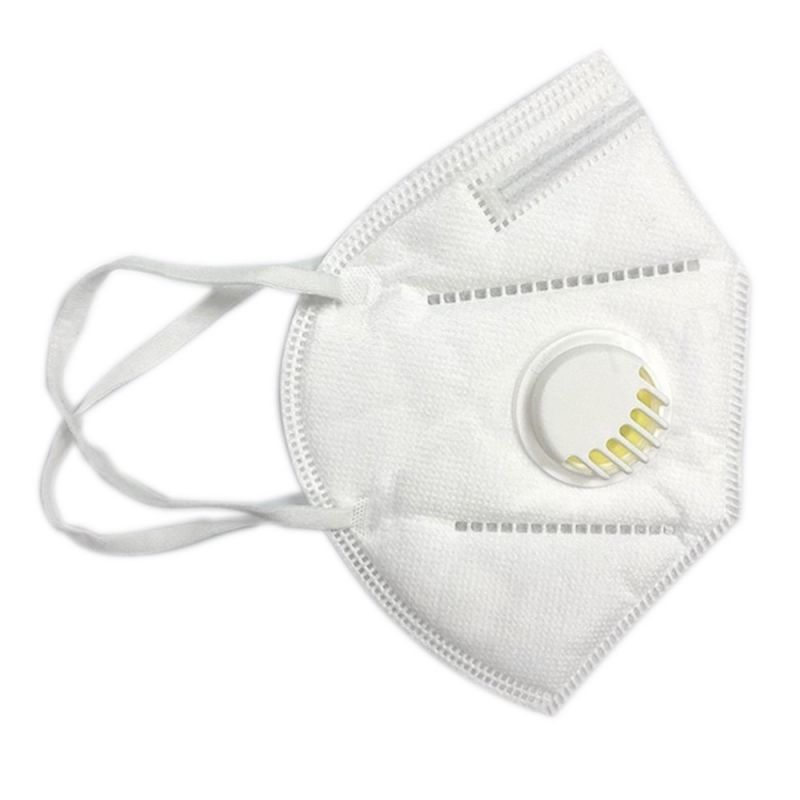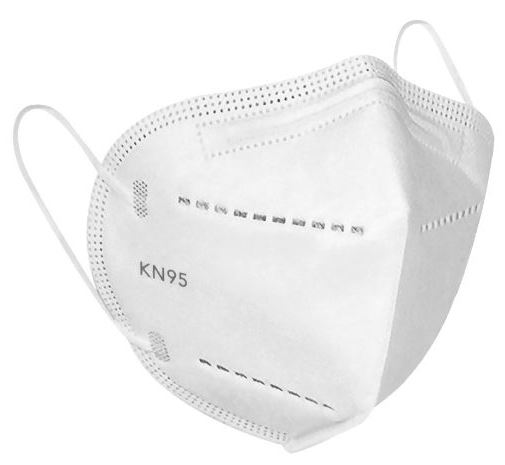RESPIRATOR FFP2/N95, valved, vertical fold, disposable
Valid Article
RESPIRATOR, filtration efficiency >= 95%
Definition
Personal Protective Equipment (PPE) for general use
A device intended to be placed over the nose and mouth with a filtering face piece (FFP) for respiratory protection against dust, as well as solid and liquid aerosols.
It is made of a flexible, porous fabric material that enables the user to breathe normally through the mask, and is held in place with ties that fasten at the back of the user's head.
A respirator with an exhalation valve does provide the same level of protection to the wearer as one that does not have a valve. The presence of an exhalation valve reduces exhalation resistance, which makes it easier to breathe (exhale). Some users feel that a respirator with an exhalation valve keeps the face cooler and reduces moisture build up inside the facepiece. However, respirators with exhalation valves should not be used in situations where a sterile field must be maintained (e.g., during an invasive procedure in an operating or procedure room) or if the wearer is potentially infected by an airborne micro-organism because the exhalation valve allows unfiltered exhaled air to escape into the sterile field.
Specifications
Norms
Meets the specifications of either one of the following PPE norms or equivalent:
- European norm FFP2 (EN 149+A1: 2009 "Respiratory protective devices - Filtering half masks to protect against particles - Requirements, testing, marking")
- American norm N95 (US NIOSH certification according: Respiratory Protective Devices, 42 CFR Part 84)
Most N95 respirators are manufactured for use in construction and other industrial type jobs that expose workers to dust and small particles. They are labeled "For occupational use".
| Filtering Facepiece Protection class | FFP1 | FFP2 | FFP3 |
| Filter penetration limit (at 95 L/min air flow): Filters at least xx% of airborne particles | 80% | 94% | 99.95% |
Penetration of filter material: 9 samples to test for each aerosol (Sodium chloride / paraffin oil, 95l/min, % max | 20% | 6% | 1% |
| TIL: at least 46 out of the 50 individual exercise results (i.e.10 subjects x 5 exercises) | <25% | <11% | <5% |
TIL: at least 8 out of the 10 individual wearer arithmetic means for the TIL shall be not greater than | 22% | 8% | 2% |
Breathing resistance: Maximum permitted resistance (mbar) - Inhalation 39l/min - Inhalation 95L/min - Exhalation 160l/min | 0.6 2.1 3.0 | 0.7 2.4 3.0 | 1.0 3.0 3.0 |
Technical specifications
- Polypropelene, polyester, polyethylene, aluminium
- Meets the requirements of FFP2 or N95 (FFP2 or N95 must be written on the respirator itself)
- Filtration efficiency with 0.3 µm particles: > 95% (N95) or > 94% (FFP2)
- Total Inward Leakage (TIL): <10% (N95) or <8% (FFP2)
- Penetration of the filtering material < 6% (NaCl and paraffine at 95 l/min with particles of 0.6 µm)
- Covers the nose, the mouth and the chin and providing a tight seal around the edge
- Does not collapse against the mouth
- Strong elastic straps, some models with earloops have a small silicon button for adjustment.
- With or without valve
- Non sterile, for single use
Packaging & Labelling
Box of 20 to 50 units
Instructions for use
Every time a respirator is put on, PERFORM A SEAL CHECK
If problems are met (the respirator does not collapse neither expand or if air leak is detected), adjust the respirator and retest the seal. In case the problems persist, replace the respirator and/or try another model or size. Once the respirator is correctly fitted, don't manipulate it any longer.
Precautions for Use
A respirator can be used several times by the same person for a period of 12 h maximum.
Clearly identify the name of the user on the respirator.
Between each use, the respirator must be placed in an open place, not folded, nor damaged, nor wet.
The wearing of a respirator alone does not replace the standard precautions and the administrative and environmental infection controls!
A respirator offers a valuable security if:
- the size and the model are adapted to the wearer's face
- the respirator is worn and used correctly by the wearer
- a seal check is performed by the wearer before each exposure
Some respirators have earloops instead of headstraps. These may have a looser fit or cause painfull ears after wearing during a prolonged period. Special clips have been developed to tackle this issue. (length 17.5 cm, width 2.5 cm, 4 positions possible)
Storage
- Store between 5 and 40°C
- In a dry and well-ventilated place





![[PSAFMASKR2VC] RESPIRATOR FFP2/N95, valved, cup-shaped, disposable](/web/image/product.template/548131/image_256/%5BPSAFMASKR2VC%5D%20RESPIRATOR%20FFP2-N95%2C%20valved%2C%20cup-shaped%2C%20disposable?unique=b02c2ca)